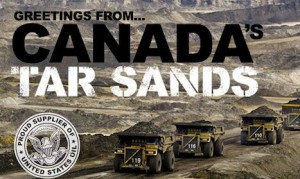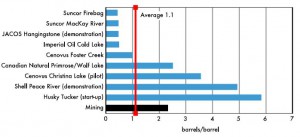 Yesterday we announced a new campaign with Lush Cosmetics to get the word out on tar sands at more than 100 LUSH stores in the US and Canada. Today, Canadian Association of Petroleum Producers (CAPP) weighed in with a press release (“God’s work”, they say) claiming that we “blur the line between fact and fiction.” A shocking assertion!
Yesterday we announced a new campaign with Lush Cosmetics to get the word out on tar sands at more than 100 LUSH stores in the US and Canada. Today, Canadian Association of Petroleum Producers (CAPP) weighed in with a press release (“God’s work”, they say) claiming that we “blur the line between fact and fiction.” A shocking assertion!
It’s the same mantra CAPP offers just about every time the industry’s challenged. They thought an ad placed in Variety Magazine was “blurring of the lines between fact and fiction.” They called a spoof video game by Polaris “inaccurate“. They challenged Al Gore invoking interest in a discussion “based on scientific facts.”
Trouble is, CAPP won’t dispute our facts. Not one! We even asked CAPP to defend their blurry assertion and take us on point-for-point, as we have occasionally done with the Government of Alberta. No dice. Canada’s oil industry would rather lob accusations than discuss substance.
No matter! We’ll keep dishing out the facts and look forward to a rebuttal in the comments.
- Oil sands mining is licensed to use twice the amount of fresh water that the entire city of Calgary uses in a year. The water requirements for oil sands projects range from 2.5 to 4.0 barrels of water for each barrel of oil produced.
- At least 90% of the fresh water used in the oil sands ends up in tailing lakes so toxic that propane cannons and floating scarecrows are used to keep ducks from landing in them.
- A 2003 report concluded that “an accident related to the failure of one of the oil sands tailings ponds could have catastrophic impact in the aquatic ecosystem of the Mackenzie River Basin due to the size of these lakes and their proximity to the Athabasca River.”
- In April, 2008 a flock of migrating ducks landed on a tar sands toxic lake and died.
- Processing the oil sands uses enough natural gas in a day to heat 3 million homes in Canada. Natural gas requirements for the oil sands industry are projected to increase substantially during the projected period from 17 million cubic metres (0.6 billion cubic feet) per day in 2003 to a range of 40 to 45 million cubic metres (1.4 to 1.6 billion cubic) feet per day in 2015.
- The toxic tailing lakes are considered one of the largest human-made structures in the world. The toxic lakes in Northern Alberta span 50 square kilometers and can be seen from space.
- Producing a barrel of oil from the oil sands produces three times more greenhouse gas emissions than a barrel of conventional oil. In 2004, oil sands production surpassed 160 000 cubic metres (one million barrels) per day; by 2015, oil sands production is expected to more than double to about 340 000 cubic metres (2.2 million barrels) per day.
- The oil sands operations are the fastest growing source of heat-trapping greenhouse gas in Canada. By 2020 the oil sands will release twice the amount produced currently by all the cars and trucks in Canada.
- The Alberta Oil Sands Operation are the largest single point source of greenhouse gas emissions in Canada.
- By 2015, the Alberta Oil Sands are expected to emit more greenhouse gases than the nation of Denmark (pop. 5.4 million).
Hat tip to Desmogblog for pulling these together with sources. For more fun facts and materials visit ran.org/tarsands
Update: Responses to comments follow
David! Steve! Welcome to the Understory. Thanks for taking the invitation for a rebuttal.
To David’s point, the fact above came from Canada’s National Energy Board in 2003. Not sure where your numbers come from David, but unfortunately the NEB numbers are the latest Government data we could find–and that’s a problem. Government doesn’t have the data that it needs to manage water impacts of tar sands development.
Steaming oil out of the ground through in-situ isn’t a solution to the water problem in the tar sands by far. Canada’s Pembina Institute has done some of the best work on this point. Below is a chart from their recent report card on In-Situ water use. Current and proposed projects could withdraw more than 15% of the Athabasca River’s water flow during its lowest flow periods, reducing the availability of fish habitat threatening health of the river’s ecosystem .

As for Steve’s comment, we’re really just comparing dueling statistics. As I’ve stated before, you have to compare apples to apples. Emissions from transit grew 36% 1990-2008 while emissions from Oil and Gas extraction grew 285%. And transit is now trending down with -.5% growth in emissions ’07 to ’08. Compare that to an increase of 2.9% from oil and gas (http://bit.ly/bTVZ1L). And that was during a downturn! NEB expects tar sands oil production to jump 11% this year (http://is.gd/bp7jW) and you can bet emissions will too.